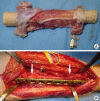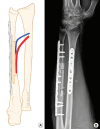Vascularized bone grafts for post-traumatic defects in the upper extremity
- PMID: 33503750
- PMCID: PMC7861969
- DOI: 10.5999/aps.2020.00969
Vascularized bone grafts for post-traumatic defects in the upper extremity
Abstract
Vascularized bone grafts (VBGs) are widely employed to reconstruct upper extremity bone defects. Conventional bone grafting is generally used to treat defects smaller than 5-6 cm, when tissue vascularization is adequate and there is no infection risk. Vascularized fibular grafts (VFGs) are mainly used in the humerus, radius or ulna in cases of persistent non-union where traditional bone grafting has failed or for bone defects larger than 6 cm. Furthermore, VFGs are considered to be the standard treatment for large bone defects located in the radius, ulna and humerus and enable the reconstruction of soft-tissue loss, as VFGs can be harvested as osteocutaneous flaps. VBGs enable one-stage surgical reconstruction and are highly infection-resistant because of their autonomous vascularization. A vascularized medial femoral condyle (VFMC) free flap can be used to treat small defects and non-unions in the upper extremity. Relative contraindications to these procedures are diabetes, immunosuppression, chronic infections, alcohol, tobacco, drug abuse and obesity. The aim of our study was to illustrate the use of VFGs to treat large post-traumatic bone defects and osteomyelitis located in the upper extremity. Moreover, the use of VFMC autografts is presented.
Keywords: Bone; Cortico-periosteal; Fibula; Graft; Microsurgery.
Conflict of interest statement
No potential conflict of interest relevant to this article was reported.
Figures











Similar articles
-
New options for vascularized bone reconstruction in the upper extremity.Semin Plast Surg. 2015 Feb;29(1):20-9. doi: 10.1055/s-0035-1544167. Semin Plast Surg. 2015. PMID: 25685100 Free PMC article.
-
Vascularized bone grafts to the upper extremities.Plast Reconstr Surg. 1998 Mar;101(3):727-35; discussion 736-7. doi: 10.1097/00006534-199803000-00022. Plast Reconstr Surg. 1998. PMID: 9500390
-
Fibula flap in upper extremity segmental/critical size bone defects fixed with locking plates. Single-institution observational cohort.Injury. 2023 Nov;54 Suppl 6:110737. doi: 10.1016/j.injury.2023.04.024. Epub 2023 Apr 14. Injury. 2023. PMID: 37072279
-
Vascularized bone grafts for upper limb reconstruction: defects at the distal radius, wrist, and hand.J Hand Surg Am. 2010 Oct;35(10):1710-8. doi: 10.1016/j.jhsa.2010.08.006. J Hand Surg Am. 2010. PMID: 20888511 Review.
-
[Vascularized periosteal transplant. A review of a new therapeutic possibility].Handchir Mikrochir Plast Chir. 1991 May;23(3):149-56. Handchir Mikrochir Plast Chir. 1991. PMID: 1869110 Review. German.
Cited by
-
Evaluation of the results of reconstruction of large bony defects of humerus using vascularized bone grafts.J Hand Microsurg. 2024 Dec 8;17(2):100198. doi: 10.1016/j.jham.2024.100198. eCollection 2025 Mar. J Hand Microsurg. 2024. PMID: 39802880
-
The Use of Free Fibula Flap in Different Extremities and Our Clinical Results.Cureus. 2023 Oct 22;15(10):e47450. doi: 10.7759/cureus.47450. eCollection 2023 Oct. Cureus. 2023. PMID: 37877106 Free PMC article.
-
Deep Circumflex Iliac Artery Osteoseptocutaneous Flap as a Reconstruction Method for Distal Radius Recurrent Giant Cell Tumour in the Case of a Bilateral Peroneal Magna Artery: An Eight-Year Follow-Up.Cureus. 2024 Sep 16;16(9):e69547. doi: 10.7759/cureus.69547. eCollection 2024 Sep. Cureus. 2024. PMID: 39416558 Free PMC article.
-
Osteocutaneous Radial Forearm Flap: Harvest Technique and Prophylactic Volar Locked Plating.Plast Reconstr Surg Glob Open. 2023 Nov 27;11(11):e5449. doi: 10.1097/GOX.0000000000005449. eCollection 2023 Nov. Plast Reconstr Surg Glob Open. 2023. PMID: 38025608 Free PMC article.
-
[Cancellous bone harvesting from the distal radius for reconstruction of bone defects in the hand].Oper Orthop Traumatol. 2025 Feb;37(1):70-75. doi: 10.1007/s00064-024-00879-1. Epub 2024 Dec 27. Oper Orthop Traumatol. 2025. PMID: 39729117 German.
References
-
- Klifto CS, Gandi SD, Sapienza A. Bone graft options in upper-extremity surgery. J Hand Surg Am. 2018;43:755–61. - PubMed
-
- Khan SN, Cammisa FP, Jr, Sandhu HS, et al. The biology of bone grafting. J Am Acad Orthop Surg. 2005;13:77–86. - PubMed
-
- Taylor GI, Miller GD, Ham FJ. The free vascularized bone graft: a clinical extension of microvascular techniques. Plast Reconstr Surg. 1975;55:533–44. - PubMed
-
- Adani R, Delcroix L, Innocenti M, et al. Reconstruction of large posttraumatic skeletal defects of the forearm by vascularized free fibular graft. Microsurgery. 2004;24:423–9. - PubMed
-
- Safoury Y. Free vascularized fibula for the treatment of traumatic bone defects and nonunion of the forearm bones. J Hand Surg Br. 2005;30:67–72. - PubMed
LinkOut - more resources
Full Text Sources
Other Literature Sources

